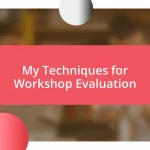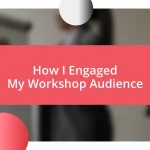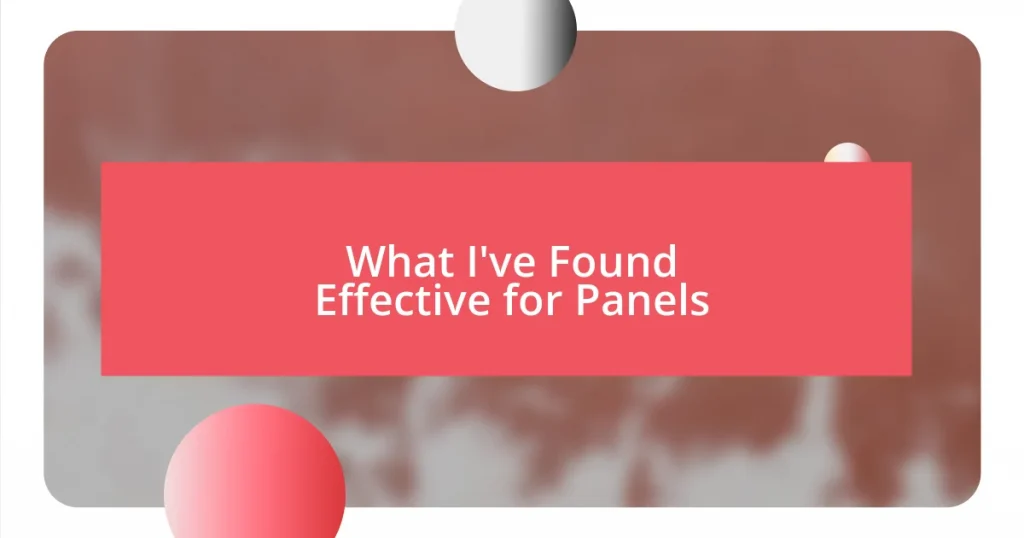Key takeaways:
- Thorough preparation, including audience research and mock Q&A sessions, boosts confidence and enhances communication effectiveness.
- Understanding panel dynamics, including individual styles and non-verbal cues, allows for better engagement and smoother interactions during presentations.
- Post-session follow-up with appreciation, audience feedback, and personal reflection fosters ongoing connections and personal growth.

Preparing for Panel Q&A Sessions
When I first approached panel Q&A sessions, I felt a mix of excitement and nerves. Preparing thoroughly was my safety net. I found that dedicating time to research my audience and understanding their interests helped me tailor my responses effectively. Have you ever considered how knowing what your audience values can dramatically change the way you present your ideas?
I remember one particular session where I practiced with a trusted coworker who posed challenging questions. This experience was a game changer. It not only helped me anticipate tough inquiries but also built my confidence, so I wasn’t thrown off guard. How often do we underestimate the power of mock sessions?
One essential tip I picked up is to create a list of potential questions and rehearse concise, articulate answers. I would even jot down my emotions related to specific topics, as this helped me connect more deeply during the actual Q&A. Have you ever noticed how our feelings can shape our communication? Preparing emotionally, alongside the content, truly made me feel more grounded when facing a panel.

Understanding Panel Dynamics
Understanding panel dynamics can truly shape the outcome of your presentation. When facing a panel, I quickly learned that each member brings unique perspectives and personalities to the table. One experience that stands out was when I encountered a panelist with a very analytical approach; their questions were precise and data-driven. This taught me the importance of adapting my communication style on the spot. I realized that anticipating their responses based on their demeanor could create a smoother flow in our conversation. Have you ever adjusted your approach mid-discussion to connect better with your audience?
During a recent session, I noticed the interplay between panelists could influence their questioning and engagement levels. For instance, when one panelist made a light-hearted comment, it lightened the mood and encouraged others to participate more freely. This experience highlighted how understanding these dynamics could keep the discussion lively. Establishing rapport with the panel can sometimes breathe new life into the session, making it feel more like a dialogue than a series of interrogations. Is there a moment where you felt a shift in energy just by engaging with your audience?
Recognizing non-verbal cues is another aspect I embraced over time. I remember one panelist crossing their arms, which initially made me feel defensive. However, I decided to interpret it as thoughtfulness rather than disinterest. By maintaining my composure, I was able to focus on delivering my answers rather than worrying about the panel’s perceptions. This shift in my perspective proved invaluable, reminding me that perceptions can differ from reality. Have you taken a moment to interpret the body language of those you’re presenting to?
| Panel Dynamics | Impact on Interaction |
|---|---|
| Individual Styles | Allows for tailored responses |
| Interplay Between Panelists | Influences flow and engagement |
| Non-Verbal Cues | Shapes interpretation of responses |

Strategies for Effective Communication
Effective communication during panel Q&A sessions goes beyond just the words you choose. In my experience, establishing a genuine connection with the panelists plays a crucial role. I recall a session where I shared a related personal story that made even the most formal panelists nod and smile. It shifted the atmosphere from stiff to inviting, encouraging open dialogue. When emotions resonate, it creates a comfortable space for questions and answers, turning what could feel like a high-pressure interrogation into an engaging conversation. How do you think storytelling can transform a formal discussion into something more relatable?
Here are some strategies I found useful for fostering effective communication:
- Be Authentic: Share your experiences; people connect with real stories.
- Ask Clarifying Questions: This not only shows engagement but also ensures you address the panel’s concerns accurately.
- Utilize Strong Body Language: Open posture and eye contact can help convey confidence and invite interaction.
- Practice Active Listening: Acknowledge the panelists’ points and build upon them, creating a back-and-forth that feels like a dialogue.
- Stay Calm and Collected: Even if questions take a challenging turn, maintaining your composure can demonstrate professionalism.
Every session offers an opportunity for growth, and these strategies helped me navigate even the toughest panels with ease. What communication tips have you found useful in your presentations?
Mastering effective communication also means being aware of your tone and pace. There was a time when I rushed through answers, thinking faster meant better. However, after receiving feedback, I learned that a slower, more measured delivery not only made my responses clearer but also gave me time to think and engage with the panel. I remember an instance where slowing down allowed me to notice a subtle smile from a panelist after addressing a particularly sensitive topic. That moment boosted my confidence and encouraged me to elaborate further. Have you ever noticed how a simple change in delivery can reshape the entire interaction?
To refine your communication further, consider implementing these techniques:
- Adjust Your Delivery Speed: Pausing gives weight to your responses and allows for reflection.
- Use Visual Aids Wisely: Tools such as slides or charts can enhance understanding if integrated smoothly.
- Speak with Confidence: Your conviction persuades the panel that your insights are worth hearing.
With time and practice, these strategies not only enhanced my communication skills but also made every session more enjoyable. What methods do you rely on to present your best self during Q&A sessions?

Handling Difficult Questions
Handling difficult questions can sometimes feel like facing a storm. I remember a time when a panelist posed a particularly challenging question about a project I had led. Instead of panicking, I took a deep breath and rephrased the question in my mind. This allowed me to address the core issue rather than getting sidetracked by the intensity of the moment. Have you ever found that taking a moment to reframe a question can change your entire approach?
Another experience that stands out was during a panel when I was confronted with a question that seemed overly critical of my methodology. I recognized the tension in the room, and instead of defensively responding, I paused and validated the concern. I acknowledged the panelist’s perspective and then shared an example of how that very methodology had led to positive outcomes in the past. This technique not only diffused the situation but also created a more constructive dialogue. How do you usually respond when someone challenges your ideas?
Sometimes, it’s all about perspective and humility. I vividly recall a session where I was caught off guard by a tough question about a competitor’s success. Instead of deflecting, I admitted that they had done some things brilliantly. I then pivoted to highlight what I had learned from them and how I planned to integrate those insights into my work. This approach not only showcased my willingness to learn but also turned what could have been a negative moment into a point of connection with the panelists. Have you ever turned a potential obstacle into an opportunity for growth?
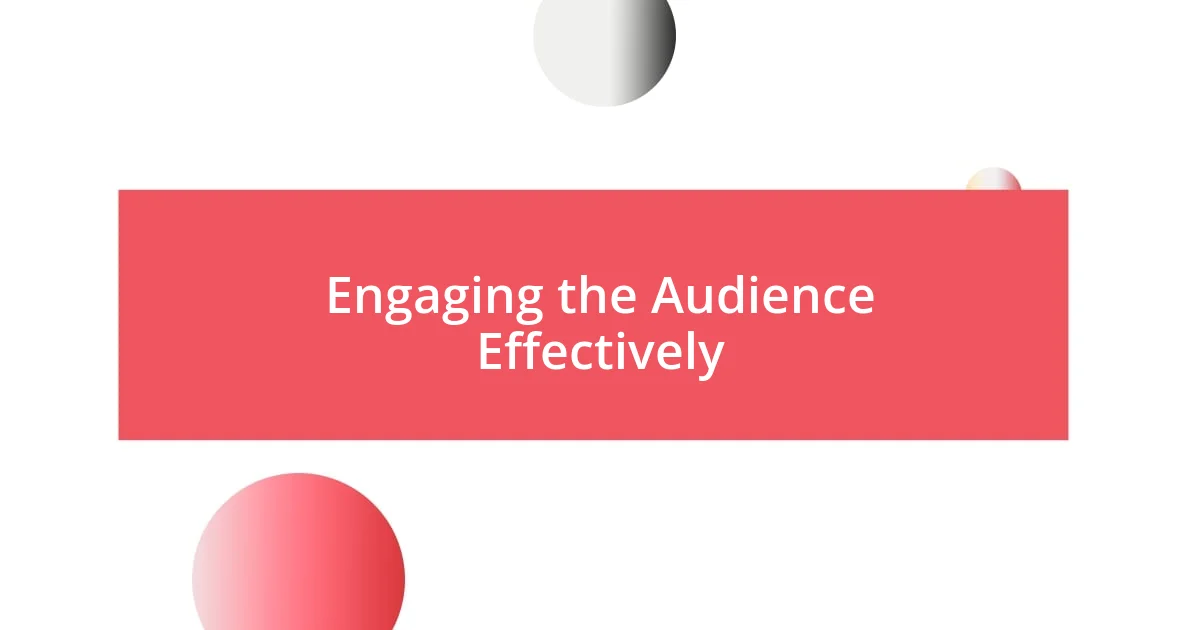
Engaging the Audience Effectively
Engaging the audience is about more than just delivering information; it’s about creating an atmosphere where participants feel valued and involved. I once facilitated a panel session where I encouraged audience members to raise their hands to share their thoughts immediately after I posed a question. Seeing those eager expressions was invigorating, and their contributions often sparked discussions that led to even deeper insights. It was a real reminder of how effective audience engagement can transform a monologue into a dynamic conversation. Have you ever felt the energy shift when someone in the audience participates?
One effective strategy I implemented was to incorporate real-time polls during my Q&A. I remember a session where we used an audience response system to gauge opinions on various topics before diving into discussions. It was eye-opening to see participants light up as their views were acknowledged, which made the dialogue feel more inclusive. This real-time interaction encouraged others to chime in, creating a lively exchange rather than a one-sided conversation. How do you think technology can enhance audience engagement in your sessions?
I also like to create a friendly atmosphere by sprinkling in humor when appropriate. I recall a panel where I made a light-hearted comment after a potentially dry question, and the audience erupted in laughter. That simple moment broke any lingering tension and made the session feel more relaxed. Encouraging light moments can really invite your audience to engage, making them more open to asking questions and sharing their thoughts. What light-hearted moments have you experienced that brought warmth to a discussion?
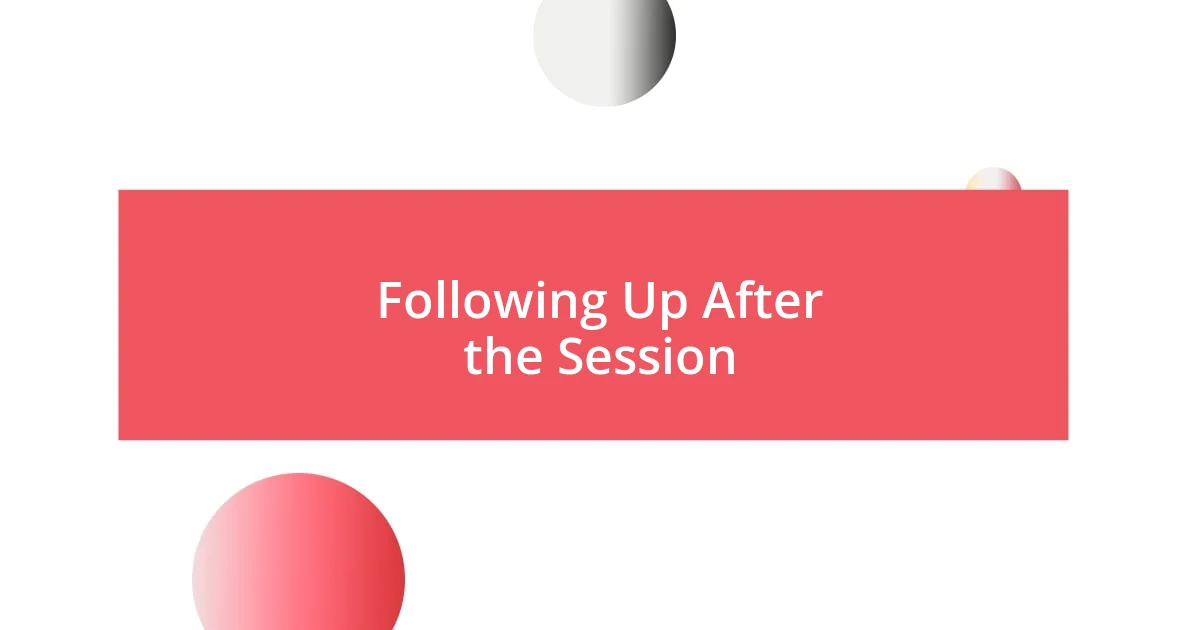
Following Up After the Session
Once the panel QA session wraps up, I always make it a point to follow up with both the panelists and the audience. For instance, after a particularly lively discussion on industry trends, I sent out a thank-you email to the panelists, expressing my appreciation for their insights and inviting them to help continue the conversation on social media. It’s a small gesture, but it reinforces the connections made during the session. Have you noticed how a simple thank-you can open doors for future collaborations?
I also collect feedback from the audience to improve my future sessions. There was a time when I sent out a quick survey after a session that focused on innovative strategies, and the responses were invaluable. Not only did they help me identify what resonated with the participants, but they also provided fresh ideas for topics to explore next. What kind of feedback do you find most beneficial after a presentation?
Additionally, I often take a moment to reflect on what I learned during the session. I’ll jot down a few lines in my notes about any unexpected insights from the panelists or audience contributions that stood out to me. This reflection helps me grow, and sometimes, I even share these thoughts in a follow-up blog post. That’s a wonderful way to provide added value and keep the discussion alive. How do you integrate new ideas into your work after a presentation?




